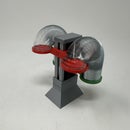Introduction: Marblevator, Tracks.
All of the Marblevators I've designed so far had a mechanism to move a marble from the end of the track to the start of the track. "Marblevator, Tracks" takes a different approach in that the tracks themselves move in concert so that the end of one track meets the start of a second track allowing the marble to transfer to the start of the second track, then the process repeats.
To synchronize the tracks, I've utilized a motor speed controller in the design of the model. Subtle adjustments to the speed controller can be made so that the marble seamlessly traverses from one track to the other.
Designed using Autodesk Fusion 360, sliced using Ultimaker Cura 4.12.1, and 3D printed in PLA on Ultimaker S5s and an Ultimaker 3e.
Supplies
Soldering iron and solder.
AWG 22 red and black stranded wire.
Thick cyanoacrylate glue.
Step 1: Parts.
I acquired the following parts:
- One 100rpm 6vdc n20 gear motor.
- One "1.8v 3v 5v 6v 7.2v 12v 2A 30W low voltage DC motor speed controller PWM 1803BK adjustable drive switch with speed control knob".
- One four AAA cell switched battery pack.
- One 12mm plastic marble.
I 3D printed the following parts at .15mm layer height, 20% infill and no supports:
- One "Base.stl
- Three "Bolt (M8 by 1.25 by 14mm).stl".
- Two "Gear Axle.stl".
- One "Gear Left.stl".
- One "Gear Motor.stl".
- One "Gear Plate.stl".
- One "Gear Right.stl".
- One "Guide.stl".
- One "Slide Left.stl".
- One "Slide Right.stl".
- Three "Spacer.stl".
- One "Track Left.stl".
- One "Track Right.stl".
This is a high precision 3D print and assembly model using at times very small precision 3D printed parts in very tight spaces. Prior to assembly, test fit and trim, file, sand, polish, etc. all parts as necessary for smooth movement of moving surfaces, and tight fit for non moving surfaces. Depending on you printer, your printer settings and the colors you chose, more or less trimming, filing, sanding and/or polishing may be required. Carefully file all edges that contacted the build plate to make absolutely certain that all build plate "ooze" is removed and that all edges are smooth. I used small jewelers files and plenty of patience to perform this step.
The model also uses threaded assembly thus an M8 by 1.25 tap and die will assist with thread cleaning if necessary.
Attachments
Step 2: Assemble the Gear Plate.
To assemble the gear plate, I performed the following steps:
- Soldered 80mm long red and black wires to the gear motor "+" and "-" terminals.
- Pressed the gear motor into "Gear Plate.stl".
- Attached "Gear Right.stl" to the gear plate assembly using one "Gear Axle.stl".
- Attached "Gear Left.stl" to the gear plate assembly using one "Gear Axle.stl".
- Made certain both gears rotated with ease.
- With the "R" on the right gear upwards and the "L" on the left gear downwards, pressed "Gear Motor.stl" onto the motor shaft and adjusted such that the motor gear surfaces aligned with the right and left gears.
Step 3: Assemble the Guide Plate.
To assemble the guide plate, I performed the following steps:
- Glued "Track Right.stl" to "Slide Right.stl".
- Glued "Track Left.stl" to "Slide Left.stl".
- Slid the right and left track assemblies into "Guide.stl" making certain each assembly slid in the guide with ease.
- Aligned the gear plate assembly with the track assemblies such that the pins on the right and left gears fit into the slots in the right and left track assemblies, then secured the gear plate assembly in place using three "Bolt (M8 by 1.25 by 14mm).stl" and three "Spacer.stl".
Step 4: Final Assembly.
For final assembly, I performed the following steps:
- Placed the guide assembly into "Base.stl" and glued in place with small dots of glue.
- Attached the motor wires to the motor speed controller "Motor" pins, red to "+" and black to "-".
- Attached the battery pack wires to the motor speed controller "Power" pins, red to "+" and black to "-".
With assembly complete, I turned on the battery pack and motor speed controller, placed the 12mm plastic marble on the track, then carefully adjusted the speed controller to attain the designed operation. The marbles I purchased very in size and weight, so careful selection may be necessary to attain the designed operation.
And that is how I 3D printed and assembled "Marblevator, Tracks".
I hope you enjoyed it!


























